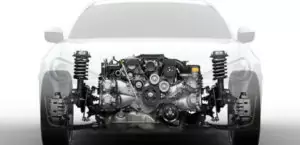The 3.5-liter V6 Isuzu 6VE1 engine was produced by the Japanese concern from 1998 to 2004 and was installed on the company’s largest SUVs and their counterparts from other manufacturers. There was a version of this engine with direct fuel injection, but it was produced for only one year.
Engines of the V-series: 6VD1, 6VE1.
Specifications
| Production years | 1998-2004 |
| Displacement, cc | 3494 |
| Fuel system | injector (6VE1-W) direct injection (6VE1-DI) |
| Power output, hp | 215 |
| Torque output, Nm | 310 (6VE1-W) 315 (6VE1-DI) |
| Cylinder block | aluminum V6 |
| Block head | aluminum 24v |
| Cylinder bore, mm | 93.4 |
| Piston stroke, mm | 85 |
| Compression ratio | 9.1 (6VE1-W) 11.0 (6VE1-DI) |
| Features | DOHC |
| Hydraulic lifters | no |
| Timing drive | belt |
| Phase regulator | no |
| Turbocharging | no |
| Recommended engine oil | 5W-30 |
| Engine oil capacity, liter | 5.4 |
| Fuel type | petrol |
| Euro standards | EURO 3 (6VE1-W) EURO 4 (6VE1-DI) |
| Fuel consumption, L/100 km (for Isuzu VehiCROSS 2000) — city — highway — combined |
18.6 10.2 13.8 |
| Engine lifespan, km | ~330 000 |
| Weight, kg | 185 |
The engine was installed on:
- Isuzu Axiom 1 (UP) in 2001 – 2004;
- Isuzu Trooper 2 (UB2) in 1998 – 2002;
- Isuzu VehiCROSS 1 (UG) in 1999 – 2001;
- Isuzu Wizard 2 (UE) in 1998 – 2004;
- Opel Monterey A (M92) in 1998 – 1999;
- Acura SLX in 1998 – 1999.
Disadvantages of the Isuzu 6VE1 engine
- The unit has no particular problems with reliability, but its fuel consumption is too big.
- You need to understand that rare engines have problems with service and spare parts.
- Most of the complaints on specialized forums are somehow related to the oil burner.
- Also, owners often discuss the failure and replacement of fuel injectors.
- Once every 100,000 km, you need to adjust the valves, every 100,000 km, change the timing belt.







You cannot adjust the valves in this engine. as stated in disadvantages.